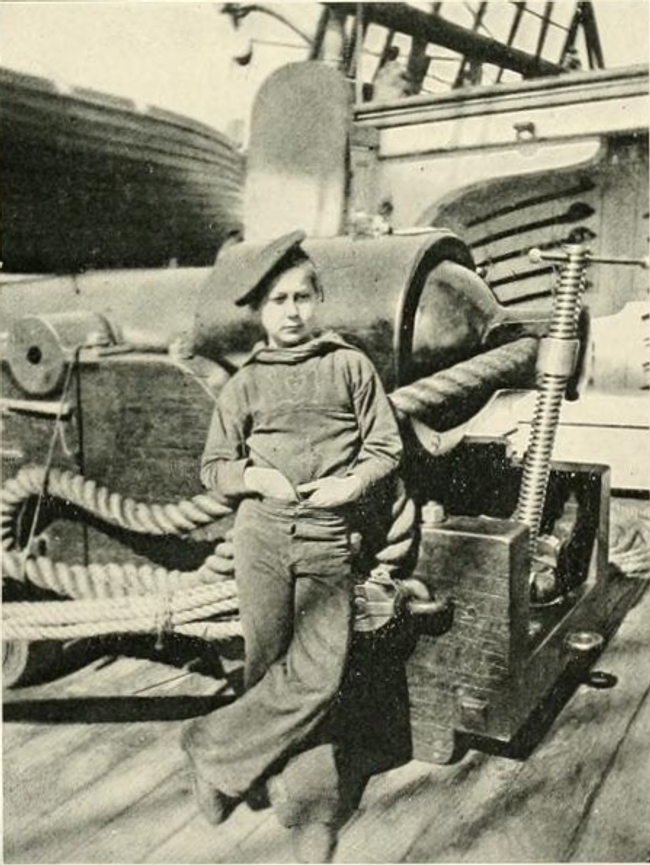Powder Monkey on:
[Wikipedia]
[Google]
[Amazon]

 A powder boy or powder monkey manned
A powder boy or powder monkey manned
History of HMS Victory: Crew
{{DEFAULTSORT:Powder Monkey Children in war Marine occupations Obsolete occupations Combat occupations Naval ranks Nautical terminology Military ranks of the Royal Navy Gunpowder

 A powder boy or powder monkey manned
A powder boy or powder monkey manned naval artillery
Naval artillery is artillery mounted on a warship, originally used only for naval warfare and then subsequently used for naval gunfire support, shore bombardment and anti-aircraft roles. The term generally refers to tube-launched projectile-firi ...
guns as a member of a warship's crew, primarily during the Age of Sail
The Age of Sail is a period that lasted at the latest from the mid-16th (or mid- 15th) to the mid- 19th centuries, in which the dominance of sailing ships in global trade and warfare culminated, particularly marked by the introduction of naval ...
. His chief role was to ferry gunpowder
Gunpowder, also commonly known as black powder to distinguish it from modern smokeless powder, is the earliest known chemical explosive. It consists of a mixture of sulfur, carbon (in the form of charcoal) and potassium nitrate (saltpeter). ...
from the powder magazine in the ship's hold to the artillery pieces, either in bulk or as cartridges, to minimize the risk of fires and explosions. The function was usually fulfilled by boy seamen of 12 to 14 years of age. Powder monkeys were usually boys or young teens, selected for the job for their speed and height: they were short and could move more easily in the limited space between decks and would also be hidden behind the ship's gunwale
The gunwale () is the top edge of the hull of a ship or boat.
Originally the structure was the "gun wale" on a sailing warship, a horizontal reinforcing band added at and above the level of a gun deck to offset the stresses created by firing ...
, keeping them from being shot by enemy ships' sharpshooters. These powder monkeys held no official naval rank on the ships that they sailed on. Some women and older men also worked as powder monkeys.
Many of the powder monkeys in the British Navy that ended up on ships were part of the poor working class. The Marine Society
The Marine Society is a British charity, the world's first established for seafarers. In 1756, at the beginning of the Seven Years' War against France, Austria, and Saxony (and subsequently the Mughal Empire, Spain, Russia and Sweden) Britain ur ...
that promoted youths to join the British Royal Navy
The Royal Navy (RN) is the United Kingdom's naval warfare force. Although warships were used by English and Scottish kings from the early medieval period, the first major maritime engagements were fought in the Hundred Years' War against F ...
recruited them by providing clothes, bedding, and a rudimentary education. In the mid-1790s, it is estimated that the Marine Society was sending five or six hundred boys a year to the fleet, although not all of these boys became powder monkeys. Of the boys who were recruited by the Marine Society, most had no other option than to join the navy, as their parents could not afford to raise them. However, a significant number had familial ties to the sea. This group had cousins, fathers, and even grandfathers who were sailors, thus making them want to continue family traditions and exploit their sense of adventure.
The United States did not have an established navy until after its independence in 1776, and even then it was loosely organized. The United States Navy
The United States Navy (USN) is the maritime service branch of the United States Armed Forces and one of the eight uniformed services of the United States. It is the largest and most powerful navy in the world, with the estimated tonnage of ...
started using powder monkeys in the late 1700s after modeling its structure upon the Royal Navy. The nations fought against each other in the War of 1812
The War of 1812 (18 June 1812 – 17 February 1815) was fought by the United States of America and its indigenous allies against the United Kingdom and its allies in British North America, with limited participation by Spain in Florida. It bega ...
, during which time both sides utilized the special physical gifts that powder monkeys offered on board their warships. After the War of 1812, boys under the age of twelve were forbidden by the U.S. Navy from serving on ships. However, boys above that age were still used as powder monkeys until the Spanish–American War
, partof = the Philippine Revolution, the decolonization of the Americas, and the Cuban War of Independence
, image = Collage infobox for Spanish-American War.jpg
, image_size = 300px
, caption = (clock ...
at the end of the nineteenth century.
The Royal Navy
The Royal Navy (RN) is the United Kingdom's naval warfare force. Although warships were used by English and Scottish kings from the early medieval period, the first major maritime engagements were fought in the Hundred Years' War against F ...
first began using the term "powder monkey" in the 17th century. The term was later used, and continues to be used in some countries, to signify a skilled technician or engineer who engages in blasting work, such as in the mining or demolition industries. In such industries, a "powder monkey" is also sometimes referred to as a "blaster".
References
External links
History of HMS Victory: Crew
{{DEFAULTSORT:Powder Monkey Children in war Marine occupations Obsolete occupations Combat occupations Naval ranks Nautical terminology Military ranks of the Royal Navy Gunpowder